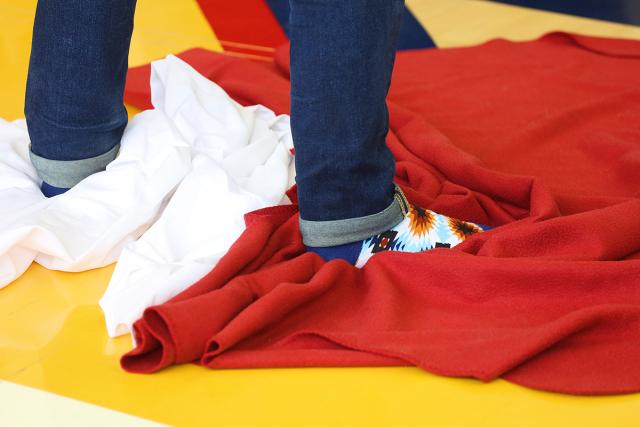The KAIROS blanket exercise powerfully shows how settlers took away land—and with it, rights and dignity—from Indigenous peoples.

I was sitting in the basement at Windermere United in Toronto on a dreary Sunday afternoon. I felt heartsick and numb as I stared down at pieces of cloth that were crumpled and cast aside on the floor.
I had just participated in a KAIROS blanket exercise, which uses blankets to powerfully show how settlers took away land—and with it, rights and dignity—from Indigenous peoples. The few colourful remnants of material left on the dull carpet represented the colossal impact of colonization: vibrant communities, cultures, and families ripped apart. (Learn more about the blanket exercise.)
The exercise is an active history lesson that puts participants (who were all white in my group) in an uncomfortable position: in the place of Indigenous peoples who our ancestors abused for more than a century.
We shuffled to and from increasingly smaller patches of blanket on the floor as historical events such as the 1876 Indian Act and the development of the residential school system unfolded. Our numbers dwindled, too as we were asked to step out of the exercise to show that not just land, but lives were lost.
There was a poignant silence to remember those who died as a result of their experience in residential schools. As a mother, this is the part of Canada’s history that I struggle with the most. It is unconscionable to think of taking children away from their homes and family—but we did. The quiet reflection gave me solace because it is the first opportunity I have ever had to honour residential school victims.
At the end of the workshop, the room was thick with our unspoken sadness, shame, and anger over the church’s role in the egregious treatment of Indigenous Canadians. Then one of the group leaders, Sara Stratton, who works in the Aboriginal Ministries Circle at the General Council office in Toronto, asked us to give words to our feelings.
One person confessed to realizing she had “the dark shadow side of the European settler” in her DNA. Several individuals expressed shock at how God and Christianity were so profoundly mispresented. One participant said the exercise prompted her to reflect on President Trump’s travel ban on people from Muslim countries, as well as racist and violent attacks on mosques and synagogues, which are on the rise around the world. “You see how quickly this [denigrating and decimating another culture] can happen when we have no respect for those that we consider ‘the other,’” she said.
I was most struck by recent events, such as the 60s scoop and the residential schools that were populated when I was a young child. And I am dumbfounded as to why there was no rousing civil rights movement in this country; no massive protests by white Canadians over the treatment of our Indigenous brothers and sisters.
Perhaps the most powerful lesson of the exercise was showing us that we have work to do in the blankets left askew. The Truth and Reconciliation Commission chairman, Justice Murray Sinclair said: “We have described for you a mountain… We call upon you to do the climbing.” The blanket exercise shows us what was and still is so astoundingly wrong in our relationship with Indigenous peoples. It is up to us to decide how we will put it right.
— Kathryn Dorrell is the editor of United Church’s Mandate magazine.